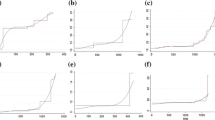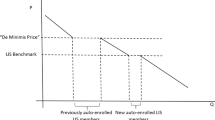Abstract
Much discussion and effort have been devoted to the use of market power screens to detect market power that might arise from existing generation asset portfolios or utility acquisition of new generation assets. The quest is to find the “Holy Grail”: a market power detection mechanism that minimizes the costs to all parties involved while finding the majority of market power exercises. This article contends that market power screens should be utilized with caution in policy and litigation applications because while they meet the criteria of minimizing enforcement costs, they are often unable to detect many types of market power exercises that an electric utility might undertake. The article begins with a discussion of the polestar for all screens—the Department of Justice/Federal Trade Commission Horizontal Merger Guidelines—and its limitations. Next, the article examines the accidentally correct, absolutely incorrect, and other outcomes that arise from the application of screens using FERC’s merger policy statement, “contestable load” analysis, and other examples. The Article concludes by noting that many types of market power exercises are undetectable with market power screens, and that better approaches would increase the probability of detection, given the low level of penalty current imposed upon those that wield market power.
Similar content being viewed by others
References
American Electric Power. (2004). Response of AEP to October 29, 2004 Deficiency Letter, Docket No. ER96-2495-023. November 19, 2004.
American Public Power Association and the Transmission Access Policy Study Group. (2005). Comments before the Federal Energy Regulatory Commission, in Re Market Based Rates for Public Utilities, Docket No. RM04-7-000. Retrieved from http://www.appanet.org/files/PDFs/APPATAPS_Searchable.pdf.
Borenstein S. (2002) The trouble with electricity markets and California’s electricity restructuring disaster. Journal of Economic Perspectives 16: 191–211
Bush, D., & Massa, S. (2004). Rethinking the potential competition doctrine. Wisconsin Law Review, 2004, 1035–1160.
Bush D., Mayne C. (2004) In (Reluctant) defense of Enron: Why bad regulation is to blame for California’s power woes, or why antitrust law fails to protect against market power when the market rules encourage its use. Oregon Law Review 83: 207–286
Centolella, P. A. (1996). The organization of competitive wholesale power markets and spot price pools. Retrieved from http://www.ncouncil.org/pool.html.
Electric Utility Regulation Committee. (2003). Report. Energy Law Journal 24: 191–230
Federal Energy Regulatory Commission. (1997a). In re Enova Corp., 79 F.E.R.C. 61,372.
Federal Energy Regulatory Commission. (1997b). Inquiry concerning the commission’s merger policy under the federal power act: Policy Statement. Federal Register 61, 68595.
Federal Energy Regulatory Commission. (2001). In Re Wisvest-Connecticut, LLC. F.E.R.C., 96, 61,101.
Federal Energy Regulatory Commission. (2005). In re Exelon Corp., 112 F.E.R.C. 61,011, order denying reh’g, 113 F.E.R.C. 61,299.
Gilbert, R., & Newbery, D. (2008). Analytical screens for electricity mergers. Review of Industrial Organization, this issue.
Jahn, L. R. (2005). Testimony before the Federal Energy Regulatory Commission on generation market power screens. Retrieved from http://www.ferc.gov/EventCalendar/Files/20050222122839-Jahn,%20EEI.pdf
Moss, D. (2005). Surrebuttal testimony on behalf of intervenor NJPIRG Citizen Lobby, Inc., before the New Jersey State Board of Public Utilities (on file with author).
Symposium: Creating Competition in Wholesale Power Markets. (2005). Environmental & Energy Law & Policy Journal, 1.
U.S. Department of Justice. (1998). U.S. v. Enova Corp., Case No. 98-CV-583 (TFH) (D.D.C. 1998). Retrieved from http://www.usdoj.gov/atr/cases/indx47.htm.
U.S. Department of Justice. (1999). Press release: Divestitures resolve Department of Justice Investigation of New York Utility Merger. Retrieved from http://www.usdoj.gov/atr/public/press_releases/1999/214605.htm.
U.S. Department of Justice. (2000a). U.S. v. ALCOA Inc. Competitive impact statement. Retrieved from http://www.usdoj.gov/atr/cases/f4900/4922.htm.
U.S. Department of Justice. (2000b). United States v. Ingersoll-Dresser Pump Co. Federal Register 65, 55271.
U.S. Department of Justice. (2004). Policy guide to merger remedies. Retrieved from http://www.usdoj.gov/atr/public/guidelines/205108.htm.
U.S. Department of Justice. (2006). U.S. v. Exelon Corp., Case No. 1:06CV01138 (D.D.C. 2006). Retrieved from http://www.usdoj.gov/atr/cases/f216700/216785.htm.
U.S. Department of Justice and U.S. Federal Trade Commission. (1992). Horizontal merger guidelines. Retrieved from http://www.usdoj.gov/atr/public/guidelines/hmg.htm.
Werden G.J. (2002) Assigning market shares. Antitrust Law Journal 70: 67–104
Author information
Authors and Affiliations
Corresponding author
Rights and permissions
About this article
Cite this article
Bush, D. Electricity Merger Analysis: Market Screens, Market Definition, and Other Lemmings. Rev Ind Organ 32, 263–288 (2008). https://doi.org/10.1007/s11151-008-9170-3
Published:
Issue Date:
DOI: https://doi.org/10.1007/s11151-008-9170-3




